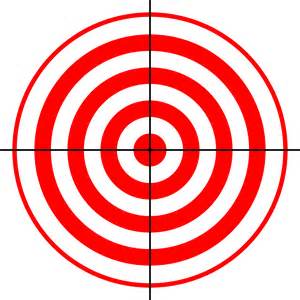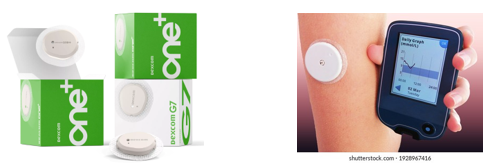4. Glucose monitoring
Introduction
Measuring glucose levels is very important for tamariki and rangatahi with diabetes. It helps to:
Check how well blood glucose is being managed and make sure the insulin you're getting is just right for your body.
Spot when blood glucose is too high (hyperglycaemia) or too low (hypoglycaemia) so it can be treated quickly.
Keep an eye on glucose levels during exercise and when you're unwell, so your diabetes can be managed safely.
This helps tamariki and rangatahi stay well, active, and confident in managing their diabetes each day.
What's a blood glucose level target?

No - not that kind of target!!
A blood glucose level target is where we think your blood glucose levels should be, to keep you well. When you meet with your diabetes team, they may give you your own blood glucose level targets that have been worked out just for you.
Generally target ranges for blood glucose levels are:
before meals 4 to 7mmol/l
after meals 5 to 10mmol/l
Time in range (time in target)
Many CGM systems track Time in Range—the percentage of time glucose levels stay within the target range. This is a great way to see how your diabetes management is going and whether any changes are needed.
Spending more time in range helps reduce the risk of both short- and long-term complications. For someone with type 1 diabetes, a good goal is to aim for at least 70% of the day with glucose levels between 4–10 mmol/L.
Using a Continuous Glucose Monitoring (CGM) sensor makes it easier to achieve this. It shows real-time glucose levels and trends, helping you make timely decisions and stay on track.
HbA1c
HbA1c is a blood test taken in clinic or in the lab that shows the average blood glucose levels over the past 3 months. It gives an overall picture of how well diabetes is being managed.
For most children and young people with diabetes, the recommended target is an HbA1c of 53 mmol/mol or lower, without frequent lows. Reaching this target helps reduce the risk of long-term complications.
Continuous Glucose Monitoring (CGM)

Continuous Glucose Monitoring (CGM) devices help tamariki and rangatahi with diabetes by tracking glucose levels throughout the day and night. They show patterns and trends over time, and most allow whānau to check levels remotely using a phone, tablet, or compatible insulin pump.
If your child doesn’t have a compatible smart device or insulin pump , CGMs can still be used with a reader or receiver, which is usually provided by the CGM company.
Some CGM devices are funded as stand-alone options, meaning they work without being connected to an insulin pump. Others are only funded—or only work—when linked to a specific insulin pump.
Not all CGM systems are compatible with all phones. Before purchasing a phone or choosing a CGM device, check the individual company’s website to confirm which phones or operating systems are supported.
Talk to your diabetes team or GP to find out which CGM device is best for your tamaiti or rangatahi.
How CGM Works
A small sensor sits just under the skin in the fatty layer.
It measures glucose in the interstitial fluid—the fluid around the body’s cells—not directly from blood.
A transmitter sends glucose data to a receiver, smart device, or insulin pump.
Because glucose takes time to move from the blood into the interstitial fluid, sensor readings may lag behind, especially after meals or insulin. This means CGM readings can sometimes be slightly different from finger-prick blood glucose levels. It doesn't mean that one sensor is better or more accurate than the other - they are just measuring glucose from different parts of the body.
👉 Important: If the sensor reading doesn’t match how your tamaiti or rangatahi feels, always check with a finger-prick.
Why CGM Helps
Shows useful patterns in glucose levels to guide insulin changes
Can sound alarms for low or high glucose—especially helpful at night
Allows families to view glucose levels in real time and support from a distance – Not available if using a reader or receiver
Helps with decisions during sport, illness, and day-to-day routines
See Glucose Monitoring Devices Comparison Table (September 2024)
A finger prick check may be needed if:
Glucose is changing quickly
Symptoms don’t match the CGM reading
If persistently high or low and not responding to required treatment
(see more info on how to do finger-prick monitoring below)
Your diabetes team will teach you how to check glucose using a finger-prick. Many tamariki and rangatahi with type 1 diabetes learn to do this themselves.
More information on CGMS
More info on Libre CGMS : https://www.mediray.co.nz/freestyle-libre-videos/
More info on Dexcom CGMS: https://nzmsdiabetes.co.nz/resource-category/patient-resources/dexcom-cgm-product-resources/dexcom-one-plus/
Blood Glucose monitoring (Finger-prick monitoring)

When should you check blood glucose levels
All tamariki with type 1 diabetes should ideally have access to continuous glucose monitoring (CGM). However, if CGM isn’t available, blood glucose levels should be checked at least four times a day:
Before breakfast
Before lunch
Before dinner
Before bed
If your tamaiti has type 2 diabetes, they may not need to check as often—this depends on the type of treatment they are on.
Even if you're using CGM, there are times when a finger-prick test may still be needed, as described above.
Your diabetes team will work with you to create a personalised testing plan, with the best times and approach to suit your child’s needs.
How to do a blood glucose test
Blood Glucose Records

All children and young people with diabetes need to keep accurate records of their blood glucose levels. In the period following diagnosis families will need to call the Diabetes Nurse Specialists every day with these levels so that changes to your insulin doses can be safely calculated.
If you're using CGM with a phone or smart device, your diabetes team can usually view your glucose data remotely through a secure platform.
If you're using a separate reader or receiver, you'll need to manually upload the data so your clinical team can see it.
It’s also important to keep a manual record of glucose levels, especially if uploading hasn’t been done recently.
Keeping a diary can be particularly helpful if multiple people are involved in your tamaiti or rangatahi’s care—such as parents, extended family, school staff, and the health care team. Writing down insulin doses and glucose levels helps improve communication and avoid confusion.
See also Diabetes Diary - https://www.kidshealth.org.nz/sites/default/files/pdfs/NZCYCN%20Diabetes%20Diary%20-%202023.pdf Ask your diabetes team if you would like a printed version. You can also print it yourself double-sided on the 'short edge' to make a booklet.
Disposal of Sharps
(Getting rid of the sharp bit in your finger-pricking device) - you're going to need an adult for this bit!
Lancets must be disposed of in approved sharp disposal containers. You can get these from your local pharmacy or online for a small fee. Once the container is full, it must be sealed with the approved lid and returned to the place you purchased it from or taken to a nominated needle exchange pharmacy for safe disposal. You can find needle exchange services here: 👉 Needle Exchange Service – Healthpoint
You can read a transcript of this video here.
More information on blood glucose testing: https://www.youtube.com/watch?v=qZCeWPnLTw4
Blood Glucose Testing - an overview. Let's go over the main points we've just covered. Ready?
Think you've got it sorted now?
If you and your parent/carer have read through the information above and watched the videos, and you feel confident that you can do this yourselves, print off and fill in the evaluation form below (you might need to ask someone to print this off for you) and return to the nurse on your ward. If you have any questions, note them down on this form and your diabetes nurse specialist will discuss them with you.
Blood Glucose Testing: Evaluation
My child and I have read the information above and watched the videos on taking a blood glucose measurement. I feel confident in supporting my child to:
| Yes | No | |
| What is Continuous Glucose Monitoring (CGMS)? | ||
| When to double check with a blood glucose test (Finger prick test) | ||
| How to undertake a blood glucose test using a blood glucose testing meter | ||
| How to record glucose and insulin doses in log book | ||
| Describe glucose targets for my child | ||
| Describe how to safely dispose of sharps |
Comments:
Date:
Name:
